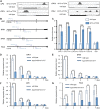TCP transcription factors suppress cotyledon trichomes by impeding a cell differentiation-regulating complex
- PMID: 33576799
- PMCID: PMC8154074
- DOI: 10.1093/plphys/kiab053
TCP transcription factors suppress cotyledon trichomes by impeding a cell differentiation-regulating complex
Abstract
Trichomes are specialized epidermal cells that act as barriers against biotic and abiotic stresses. Although the formation of trichomes on hairy organs is well studied, the molecular mechanisms of trichome inhibition on smooth organs are still largely unknown. Here, we demonstrate that the CINCINNATA (CIN)-like TEOSINTE BRANCHED1/CYCLOIDEA/PCF (TCP) transcription factors inhibit the formation of trichomes on cotyledons in Arabidopsis (Arabidopsis thaliana). The tcp2/3/4/5/10/13/17 septuple mutant produces cotyledons with ectopic trichomes on the adaxial sides. The expression patterns of TCP genes are developmentally regulated during cotyledon development. TCP proteins directly interact with GLABRA3 (GL3), a key component of the MYB transcription factor/basic helix-loop-helix domain protein/WD40-repeat proteins (MYB-bHLH-WD40, MBW) complex essential for trichome formation, to interfere with the transactivation activity of the MBW complex in cotyledons. TCPs also disrupt the MBW complex-R3 MYB negative feedback loop by directly promoting the expression of R3 MYB genes, which enhance the repression of the MBW complex. Our findings reveal a molecular framework in which TCPs suppress trichome formation on adaxial sides of cotyledons by repressing the activity of the MBW complex at the protein level and the transcripts of R3 MYB genes at the transcriptional level.
© American Society of Plant Biologists 2021. All rights reserved. For permissions, please email: journals.permissions@oup.com.
Figures







Similar articles
-
Ectopic expression of R3 MYB transcription factor gene OsTCL1 in Arabidopsis, but not rice, affects trichome and root hair formation.Sci Rep. 2016 Jan 13;6:19254. doi: 10.1038/srep19254. Sci Rep. 2016. PMID: 26758286 Free PMC article.
-
Genetic evidence suggests that GIS functions downstream of TCL1 to regulate trichome formation in Arabidopsis.BMC Plant Biol. 2018 Apr 13;18(1):63. doi: 10.1186/s12870-018-1271-z. BMC Plant Biol. 2018. PMID: 29653514 Free PMC article.
-
Genome-Wide Identification of Direct Targets of the TTG1-bHLH-MYB Complex in Regulating Trichome Formation and Flavonoid Accumulation in Arabidopsis Thaliana.Int J Mol Sci. 2019 Oct 10;20(20):5014. doi: 10.3390/ijms20205014. Int J Mol Sci. 2019. PMID: 31658678 Free PMC article.
-
GLABRA2, A Common Regulator for Epidermal Cell Fate Determination and Anthocyanin Biosynthesis in Arabidopsis.Int J Mol Sci. 2019 Oct 9;20(20):4997. doi: 10.3390/ijms20204997. Int J Mol Sci. 2019. PMID: 31601032 Free PMC article. Review.
-
Updates on molecular mechanisms in the development of branched trichome in Arabidopsis and nonbranched in cotton.Plant Biotechnol J. 2019 Sep;17(9):1706-1722. doi: 10.1111/pbi.13167. Epub 2019 Jun 11. Plant Biotechnol J. 2019. PMID: 31111642 Free PMC article. Review.
Cited by
-
Chromosome-Level Genome Assembly for Acer pseudosieboldianum and Highlights to Mechanisms for Leaf Color and Shape Change.Front Plant Sci. 2022 Mar 3;13:850054. doi: 10.3389/fpls.2022.850054. eCollection 2022. Front Plant Sci. 2022. PMID: 35310631 Free PMC article.
-
Involvement of ABA Responsive SVB Genes in the Regulation of Trichome Formation in Arabidopsis.Int J Mol Sci. 2021 Jun 24;22(13):6790. doi: 10.3390/ijms22136790. Int J Mol Sci. 2021. PMID: 34202673 Free PMC article.
-
Genome-Wide Identification and Expression Analysis of TCP Transcription Factors Responding to Multiple Stresses in Arachis hypogaea L.Int J Mol Sci. 2025 Jan 26;26(3):1069. doi: 10.3390/ijms26031069. Int J Mol Sci. 2025. PMID: 39940846 Free PMC article.
-
Arabidopsis transcription factor TCP4 represses chlorophyll biosynthesis to prevent petal greening.Plant Commun. 2022 Jul 11;3(4):100309. doi: 10.1016/j.xplc.2022.100309. Epub 2022 Mar 3. Plant Commun. 2022. PMID: 35605201 Free PMC article.
-
Comprehensive analysis of PLATZ family genes and their responses to abiotic stresses in Barley.BMC Plant Biol. 2024 Oct 18;24(1):982. doi: 10.1186/s12870-024-05690-5. BMC Plant Biol. 2024. PMID: 39420254 Free PMC article.
References
-
- Beilstein MA, Al-Shehbaz IA, Kellogg EA (2006) Brassicaceae phylogeny and trichome evolution. Am J Bot 93: 607–619 - PubMed
-
- Braybrook S, Harada J (2008) LECs go crazy in embryo development. Trends Plant Sci 13: 624–630 - PubMed
-
- Chandler JW (2008) Cotyledon organogenesis. J Exp Bot 59: 2917–2931 - PubMed
Publication types
MeSH terms
Substances
LinkOut - more resources
Full Text Sources
Other Literature Sources
Molecular Biology Databases

